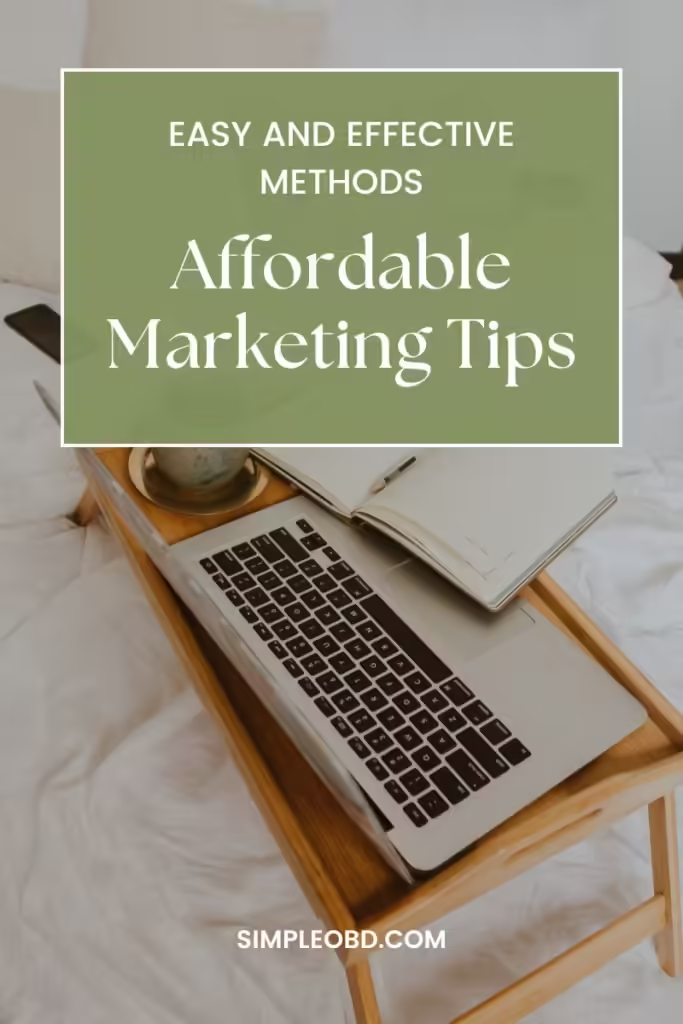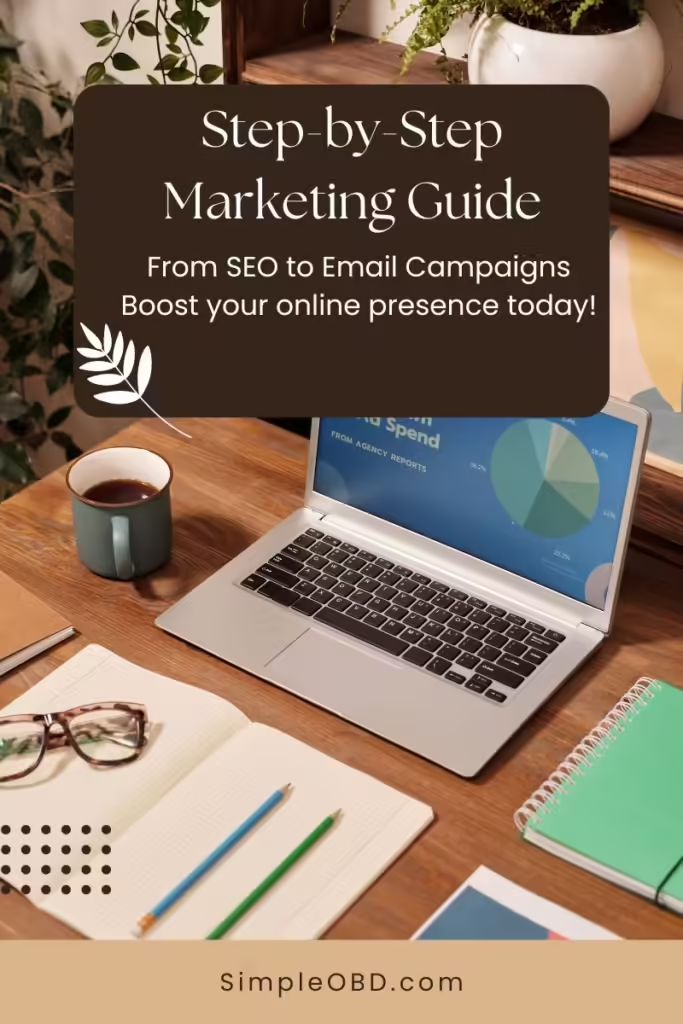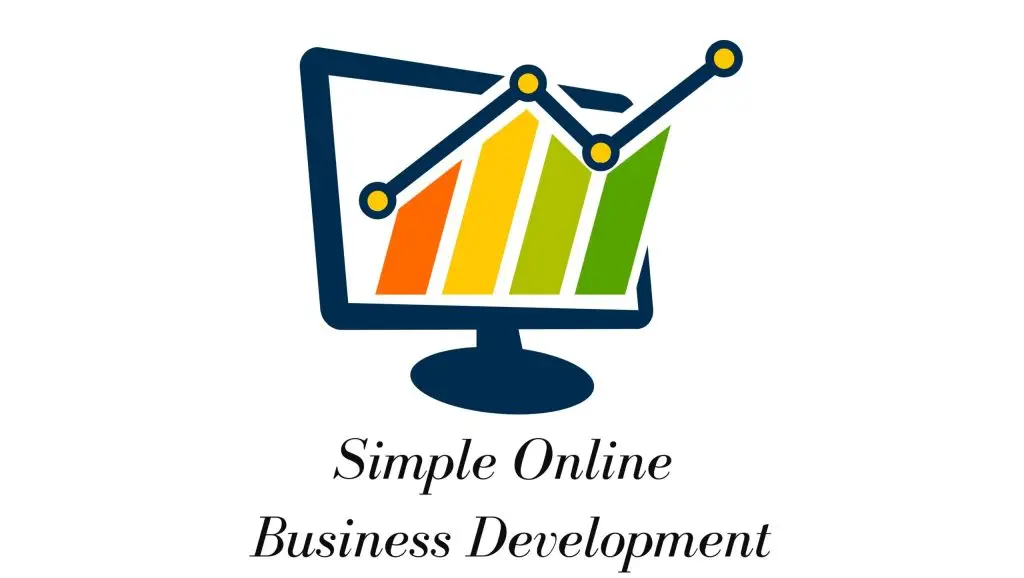If you’re a small business owner looking to grow your business without spending a fortune, you’re in the right place. Here are 10 simple and affordable online marketing tips and strategies to help your small business thrive.

1. Affordable Online Marketing
The first of our online marketing tips is about affordable marketing. Starting out with a tight budget? No worries! Utilize free or low-cost platforms like social media and content marketing to reach your target audience without breaking the bank. Social media platforms like Facebook, Instagram, and Twitter offer free accounts and tools to help you engage with your audience. So, by consistently posting valuable content, you can build a loyal following and increase brand awareness.
Furthermore, content marketing, such as blogging or creating videos, is another cost-effective way to attract and engage customers. Write informative blog posts that address common questions, or pain points your customers have. Share your expertise through how-to videos or tutorials on YouTube. Additionally, you can take advantage of free tools like Canva to create eye-catching graphics and HubSpot for managing your customer relationships and email campaigns. These methods not only save money but also allow you to connect with your audience in a meaningful way.
2. Digital Marketing for Small Businesses
Easy online marketing, or digital marketing, is all about using the internet to connect with your customers. Focus on key areas like SEO, social media, and email marketing to maximize your online presence and reach more people.
In this section, we discuss how SEO (Search Engine Optimization) is crucial for making sure your website appears in search engine results when potential customers look for products or services like yours. Start with basic SEO practices like keyword research, optimizing your website’s content, and building backlinks from reputable sites.
Social media marketing allows you to interact with your audience on platforms they already use daily. By sharing engaging content, running promotions, and responding to comments, you can build a community around your brand and foster customer loyalty.
Email marketing helps you stay in touch with your customers directly. Regular newsletters, personalized offers, and follow-up emails can keep your audience engaged and encourage repeat business. Tools like MailChimp make it easy to manage your email campaigns and track their effectiveness.
By leveraging these digital marketing strategies, small businesses can effectively compete with larger companies and build a strong online presence without the need for a massive budget.
3. Social Media MarketingSocial media is a powerful tool for small businesses. Here are some tips to make the most of it:
Platform Selection: Choose platforms where your audience spends most of their time. For example, Facebook and Instagram are great for visual content, while YouTube is ideal for video marketing. For more professional or B2B interactions, LinkedIn is a solid choice. Pinterest can be effective for businesses focusing on DIY, fashion, food, and other visually-driven industries. Keep in mine, each platform has its strengths, so pick the ones that align best with your business goals and audience.
Content Ideas: Share behind-the-scenes looks to give your audience a glimpse into your business operations. Customer stories and testimonials can build trust and show the value of your products or services. Product updates keep your followers informed about new offerings, special deals, and improvements. Additionally, running contests and giveaways can increase engagement and attract new followers. Use live videos to interact in real-time, answer questions, and provide demonstrations.
Scheduling and Management: Use tools like Hootsuite, Buffer, or Sprout Social to schedule and manage your posts efficiently. These tools allow you to plan your content calendar, ensuring consistent posting without the daily hassle. They also provide analytics to track the performance of your posts, helping you understand what works best with your audience.
So, by effectively using social media marketing, small businesses can build a loyal following, increase brand awareness, and drive more traffic to their websites, all while engaging directly with their customers.

4. Content MarketingCreating and sharing valuable content is a great way to attract and retain customers. Here’s how to do it effectively:
Types of Content: There are various types of content you can create to engage your audience. Blogs are great for providing in-depth information and improving your website’s SEO. Regularly posting blog articles on topics relevant to your industry can help establish your business as an authority in your field. Videos are particularly engaging and shareable, making them perfect for social media. You can create tutorials, product demonstrations, or behind-the-scenes looks at your business. Infographics are another excellent option as they present complex information in an easy-to-understand visual format. They are highly shareable and can drive traffic back to your website.
Content Creation Tips: Focus on producing high-quality, relevant content that addresses your audience’s needs and interests. Start by identifying common questions or problems your customers face and create content that provides solutions. Use tools like Canva for creating professional-looking infographics and video editing software like Adobe Premiere Pro or even simpler tools like iMovie for your videos. Ensure your content is visually appealing and easy to read or watch. Consistency is key, so establish a content calendar to plan and schedule your posts regularly.
Additionally, optimize your content for SEO by including relevant keywords, meta descriptions, and internal links. Promote your content across different channels, such as social media and email newsletters, to reach a broader audience. Engage with your readers by responding to comments and encouraging discussions. This not only builds a community around your brand but also provides valuable feedback and insights into your audience’s preferences.
By implementing these content marketing strategies, you can attract and retain customers, build brand loyalty, and position your business as an industry leader.
5. Email Marketing
Email marketing is one of the most effective ways to reach your audience directly. Here’s how to get started:
- Building an Email List: Collect email addresses from your website visitors by offering something valuable, like a free ebook or discount. MailChimp is a great tool to help you manage your email list.
- Crafting Effective Campaigns: Write compelling subject lines, provide valuable content, and include clear calls-to-action.
6. Local SEO
Optimizing your online presence for local search is crucial for small businesses. Here’s how to get noticed:
- Google My Business: Create and optimize your Google My Business listing to appear in local search results. Add accurate business information, photos, and encourage customer reviews.
- Local Keywords: Use local keywords in your website content and meta descriptions to attract local customers.
7. Pay-Per-Click (PPC):
Advertising can drive immediate traffic to your website. Here’s how to set up your first campaign, even if you’re new to PPC:
Introduction to PPC: PPC, or Pay-Per-Click advertising, lets you place ads on search engines like Google Ads. The best part? You only pay when someone clicks on your ad. This means you’re paying for actual visitors to your site, which can be a cost-effective way to attract potential customers.
Setting Up Your First Ad Campaign:
- Keyword Research: Start by finding the right keywords. Keywords are the words or phrases people type into search engines. Use tools like SEMrush or Google’s Keyword Planner to discover keywords relevant to your business. Look for keywords that have a good balance of high search volume and low competition.
- Create Compelling Ad Copy: Your ad copy is the text that appears in your ad. It should be clear, concise, and enticing to make people want to click. Include a strong call-to-action (CTA), like “Shop Now” or “Learn More,” to encourage clicks.
- Set a Budget: Decide how much you want to spend on your campaign. Google Ads allows you to set a daily budget, so you control how much you’re spending. Start with a small budget to test how well your ads perform and adjust as needed.
- Launch Your Campaign: Once you’ve chosen your keywords, written your ad copy, and set your budget, it’s time to launch your campaign. Monitor it regularly to see how it’s performing. Google Ads provides analytics to help you understand which ads are working and which aren’t.
- Adjust and Optimize: Based on the performance data, tweak your ads to improve their effectiveness. This might involve changing your keywords, adjusting your ad copy, or increasing your budget for ads that are performing well.
By following these steps, you can set up a PPC campaign that drives traffic to your website and helps you reach potential customers quickly and efficiently. Don’t worry if it feels a bit overwhelming at first. Practice and regular adjustments will help you get the hang of it.
8. Website Optimization
Your website is the foundation of your online presence. Here’s how to make it effective:
- Professional Design: A well-designed website builds trust and makes it easy for visitors to learn about your business. Platforms like WordPress offer great options for creating a professional look.
- User Experience: Ensure your website is user-friendly, mobile-responsive, and has clear calls-to-action. Fast loading times and easy navigation are key.
9. Simple Marketing ToolsThere are plenty of tools available to simplify your marketing efforts. Here are a few must-haves:
- Google Analytics: Track and understand your website traffic. This tool helps you see where your visitors are coming from, which pages they visit the most, and how long they stay on your site. It’s essential for making data-driven decisions.
- MailChimp: Or some type of autoresponder to manage your email campaigns. Mailchimp is a great beginner-level platform with user-friendly features. As your business grows, you might consider moving to more robust platforms like AWeber or Constant Contact for advanced features.
- Hootsuite: Manage all your social media accounts in one place. Hootsuite allows you to schedule posts, track social media performance, and engage with your audience across multiple platforms without the hassle of logging into each one separately.
- Canva: Create stunning graphics for your social media and marketing materials. Canva offers easy-to-use templates for everything from social media posts to infographics, helping you create professional-looking visuals even if you’re not a designer.
- HubSpot: Offers a suite of tools for CRM, marketing, and sales. HubSpot helps you manage your customer relationships, track leads, and automate your marketing efforts. It’s a comprehensive tool that grows with your business needs.
Using these tools can save you time, streamline your marketing processes, and help you achieve better results with less effort.
10. Easy Marketing StrategiesImplementing simple and easy strategies can make a big difference. Here are some quick wins:
Consistent Posting: Regularly posting content on your social media and blog keeps your audience engaged and helps maintain a steady flow of traffic to your website. Consistency builds trust and shows that your business is active and reliable. Create a content calendar to plan and schedule your posts in advance, ensuring you never miss a beat.
Engage with Your Audience: Interacting with your audience is crucial for building strong relationships. Respond to comments and messages promptly, whether they’re questions, compliments, or even complaints. Show your customers that you value their input and are there to help. Engagement fosters loyalty and encourages positive word-of-mouth.
Run Promotions and Contests: Promotions and contests can attract new customers and keep your current audience excited about your business. Offer discounts, giveaways, or special deals to create a buzz around your products or services. Contests can be simple, like asking followers to share a photo or comment on a post for a chance to win. These activities increase engagement, boost your visibility, and can lead to more sales.
Leverage User-Generated Content: Encourage your customers to share their own content related to your products or services. This can include photos, reviews, or testimonials. Sharing user-generated content not only provides social proof but also helps build a community around your brand.
Collaborate with Influencers: Partnering with influencers in your niche can help you reach a broader audience. Influencers have established trust with their followers, and a recommendation from them can carry a lot of weight. Choose influencers whose values align with your brand for authentic and effective collaborations.
By incorporating these easy marketing strategies, you can significantly enhance your online presence and engage more effectively with your customers. Small, consistent efforts can lead to substantial growth and long-term success.

Conclusion
Online marketing doesn’t have to be complicated or expensive. By focusing on these simple strategies and using the right tools, you can effectively boost your small business. Consistency and quality are key, so stick with it and watch your business grow!
What do you think? Have any tips or tools that have worked for you? Share your experiences in the comments below, and let’s help each other out! 🚀
Feel free to ask questions or drop your own tips in the comments! Let’s grow together! 🌱
If you found these tips helpful and want to take your online marketing to the next level, why not get some professional help? At Simple Online Business Development, we offer expert content creation services to help you engage your audience and grow your business. Reach out today for a free consultation, and let’s discuss how we can help you achieve your marketing goals.
Feel free to leave a comment or ask any questions below – we’re here to help!

Regina L Floyd
Online Marketing Consultant
SimpleOBD.com

